
|
Sale 114
The New York Sale
| Lot |
Photo |
Description |
Bidding |
Lot 1 |
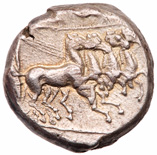 |
Sicily, Lilybaion. Silver Tetradrachm (16.80 g), ca. 325-305 BC. ['RSMLQRT'] in exergue, charioteer, holding kentron and reins, driving galloping quadriga right; above, Nike flying left, crowning charioteer with wreath. Reverse: Head of Arethusa right, wreathed with grain ears, wearing triple-pendant earring and necklace; around, four dolphins. Jenkins 51 (O18/R39); SNG ANS -; SNG Lloyd 1603 (same dies). Lightly toned. Choice Very Fine. Value $1,500 - UP
View details and enlarged photos
|
|
Lot 2 |
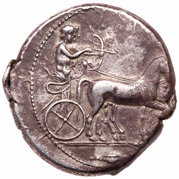 |
Sicily, Selinos. Silver Tetradrachm (17.34 g), ca. 455-409 BC. ΣEΛ-IN-[ONTION], Artemis, holding reins, driving quadriga right; beside her, Apollo standing, drawing bow; in exergue, grain ear. Reverse: Σ-EΛ-INONT-I-ON, Selinos standing facing, head left, holding patera over altar and laurel branch; on base of altar, rooster standing left; behind, selinon leaf above bull standing left on basis. Schwabacher 36 (Q11/S27); SNG ANS 700; Rizzo pl. XXXIII, 1. Fine style. Obverse somewhat off-center. Toned. Very Fine. Value $1,800 - UP
View details and enlarged photos
|
|
Lot 3 |
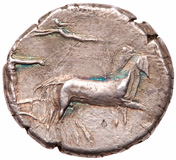 |
Sicily, Syracuse. Second Democracy. Silver Tetradrachm (17.26 g), 466-405 BC. Reverse die signed by A… Ca. 425-420 BC. Charioteer, holding reins, driving slow quadriga right; above, Nike flying left, crowning him with wreath. Reverse: ΣYPA-KOΣIO-[N], diademed head of Arethusa right, hair bound in sakkos ornamented with maeander pattern; on the sakkos above Arethusa's forehead, artist's signature: A; around, four dolphins swimming right. Boehringer 697.6 (V344/R475); Morgan 141 (this coin). Toned. Choice Very Fine. Value $1,000 - UP
The lovely head of Arethusa on this coin was engraved by an unknown master who was the first engraver at Syracuse to be allowed to sign his dies.
Ex Strozzi Collection (Galerie Sangiorgi, 15 April 1907), 1397.
View details and enlarged photos
|
|
Lot 4 |
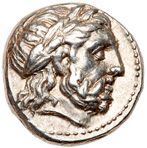 |
Macedonian Kingdom. Philip II. Silver Tetradrachm (14.38 g), 359-336 BC. Amphipolis, ca. 316-311 BC. Laureate head of Zeus right. Reverse: ΦIΛIΠ-ΠOY, youth on horseback right, holding palm branch; below horse's belly, aplustre; below raised foreleg, Π-pellet monogram. Le Rider pl. 46, 18; Troxell grp. 9, 323�5; SNG ANS 738�46. Untoned. Extremely Fine. Value $600 - UP
View details and enlarged photos
|
|
Lot 5 |
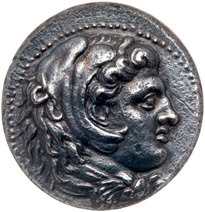 |
Macedonian Kingdom. Alexander III 'the Great'. Silver Decadrachm (41.34 g), 336-323 BC. Babylon, lifetime issue, ca. 325-323 BC. Head of Herakles to right, wearing lion's skin headdress. Reverse: AΛEΞANΔPOY, Zeus seated left, holding eagle and scepter; below throne monogram, M below; in left field bee. Price 3618A; Mnemata 6. Extremely Rare. Original dark toning. NGC grade Choice XF; Strike: 5/5, Surface: 2/5. Fine Style scratches. Value $30,000 - UP
Among the rarest and most desirable of all ancient Greek coins, the famed decadrachms of Alexander the Great were struck at Babylon from the bullion seized after the city's conquest from the Achaemenid Persians. The types follow the huge emissions of Alexander's tetradrachms, sporting the head of the mighty Herakles wearing his lion's skin on the obverse, and the father of the Olympian pantheon, Zeus, seated on the reverse. There has long been speculation that the portrait of Herakles features the likeness of Alexander himself, but there is no sure evidence that this is the case. There are only twenty or so Alexander decadrachms known to exist, and most of those were discovered in 1973 in what has become known as the 'Babylon Hoard'. The known examples suggest there was at least three separate emissions, and the paucity of remaining pieces suggest that the denomination may have served a ceremonial purpose - perhaps given as presentation pieces to high ranking officers or possibly even to soldiers who had distinguished themselves in the conquest of Persia. Alexander was known for giving largesse, and it is tempting to think that he may have taken a personal role in their distribution. Today these surviving decadrachms are a tangible example of one of the greatest treasures in ancient numismatics.
Ex Tareq Hani Collection. Officially exported by Archbshop Alexios, Greek Orthodox Church, December 8, 1967.
View details and enlarged photos
|
|
Lot 6 |
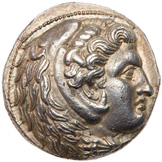 |
Macedonian Kingdom. Alexander III, the Great, 336-323 BC. Silver Tetradrachm (17g). Struck at Susa, ca. 316-311 BC. Head of young Heracles r. in lion skin headdress. Rev. Zeus enthroned l. supporting eagle on extended r. hand and holding scepter in l, wreath in left field. AI under throne with monogram below. Price 3857. Boldly struck in high relief from well executed dies. Delicately toned. Superb Extremely Fine. Value $1,000 - UP
View details and enlarged photos
|
|
Lot 7 |
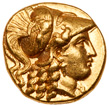 |
Macedonian Kingdom. Philip III Arrhidaios. Gold Stater (8.56 g), 323-317 BC. Babylon, ca. 323-318/7 BC. Head of Athena right, wearing crested Corinthian helmet, the bowl of which is adorned with a griffin springing right. Reverse: B-AΣIΛE[ΩΣ] ΦIΛIΠΠOY, Nike standing facing, head left, holding wreath and stylis; in left field, wheel; below each wing, monograms. Cf. Price P187ff (controls not recorded). Lustrous. Extremely Fine. Value $2,700 - UP
View details and enlarged photos
|
|
Lot 8 |
 |
Paeonian Kingdom. Patraos. Silver Tetradrachm (12.47 g), 335-315 BC. Damastion (?). Laureate head of Apollo right. Reverse: ΠATPAOY, warrior on horseback right, riding down enemy below with shield and lance; above, monogram. Paeonian Hoard 339 (same dies); cf. SNG ANS 1030-2 (same obv. die?). Toned. Choice Very Fine. Value $300 - UP
View details and enlarged photos
|
|
Lot 9 |
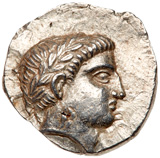 |
Paeonian Kingdom. Patraos. Silver Tetradrachm (12.72 g), 335-315 BC. Damastion (?). Laureate head of Apollo right. Reverse: Π-A-TPAOΛ, warrior on horseback right, riding down enemy below with shield and lance. Paeonian Hoard 439 (same dies); SNG ANS 1040 (same obv. die). Untoned and virtually as struck. Extremely Fine. Value $300 - UP
View details and enlarged photos
|
|
Lot 10 |
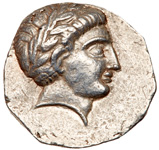 |
Paeonian Kingdom. Patraos. Silver Tetradrachm (12.49 g), 335-315 BC. Damastion (?). Laureate head of Apollo right. Reverse: ΠA-T-PA-[O]T, warrior on horseback right, riding down enemy below with shield and lance; in left field, ME monogram. Cf. Paeonian Hoard 377; cf. SNG ANS 1031. Untoned and nearly as struck. Choice Very Fine. Value $275 - UP
View details and enlarged photos
|
|
Lot 11 |
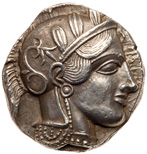 |
Attica, Athens. Silver Tetradrachm (17.16 g), ca. 440-404 BC. Helmeted head of Athena right, frontal eye. Reverse: AΘE, owl standing right, head facing; above to left, olive-spray with berry and crescent; all within incuse square. Kroll 8; Svoronos pl. 14; SNG Copenhagen 31-40. Boldly struck and perfectly centered. Superb Extremely Fine. Value $2,000 - UP
Ex CNG 108 (16 May 2018), 137; Gemini XII (11 January 2015), 122.
View details and enlarged photos
|
|
Lot 12 |
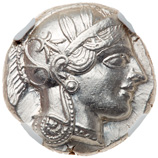 |
Attica, Athens. Ca. 440-404 BC. Silver Tetradrachm (17.20 g). Helmeted head of Athena right, frontal eye. Reverse: AΘE, owl standing right, head facing; above to left, olive-spray with berry and crescent; all within incuse square. Kroll 8; Svoronos pl. 14; SNG Copenhagen 31-40. Sharply struck in high relief and perfectly centered. A superb, intensely lustrous specimen. NGC graded Mint State, Strike: 5/5, Surface; 3/5. Value $1,500 - UP
A gem example among the vast number of Athenian "owl" tetradrachms struck in the fifth century BC. The Athenian "owls" were produced from silver from the Laurion mines of Attica and used to fund such major enterprises as the Periklean building program, which served to beautify Athens as the capital of a naval empire along with the Peloponnesian War (431-404 BC) that broke out The "owls" were widely accepted in international trade and their types became a symbol of good money. Therefore, the types remained unaltered until the introduction of the Athenian New Style coinage in circa 165 BC.
"Parliament Collection" on NGC holder.
View details and enlarged photos
|
|
Lot 13 |
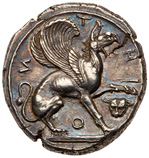 |
Ionia, Teos (c. 480-449 B.C.), an exceptional pair of Silver Staters. T-HI-O-И, winged male griffin seated right on "leaf and tongue" exergual line, wings raised, front left paw held over panther head, 11.96g; T-HI-O-И, winged female griffin seated right on ornate groundline, her neck with long fine mane above feathers or scales, breasts visible below and spines running the length of her back, wings raised, front left paw held over panther head, 11.92g. Rev. Quadripartite incuse square (Balcer, The early silver coinage of Teos, SNR 47, 103; BMC 311, 19). Of fine style, both pieces probably by the same artist with minor variations between the male and female griffins, both with a small edge split otherwise well centered and boldly struck with an iridescent and most attractive cabinet tone. Rare. Both pieces Superb Extremely Fine. Value $18,000 - UP
Both pieces featured in the book "Apollo to Apollo, The Hunt for the Divine and Eternal Beauty" by Henrik Bo Andersen.
Male griffin: Ex. Hauck & Aufhäuser Auction 20, 16 October 2007, lot 124; Female griffin: Ex Hess-Divo Auction 24 October 2007, lot 62; Male griffin - Ex. Giessener Münzhandlung Auction 46 (1989), lot 264;.
View details and enlarged photos
|
|
Lot 14 |
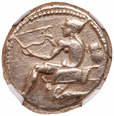 |
Cilicia, Soloi. Silver Stater (10.74 g), ca. 440-410 BC. Amazon kneeling left, quiver and bow-case at her side, holding bow; in left field, ivy leaves; in right field, helmet. Reverse: ΣΩΛEΩN, grape bunch; in right field, fly; all within incuse square. SNG BN 128; SNG Levante 40; SNG von Aulock 5858. NGC grade Ch XF*; Strike: 5/5, Surface: 4/5. Value $5,000 - UP
View details and enlarged photos
|
|
Lot 15 |
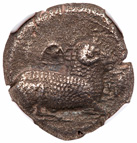 |
Cyprus, Salamis. Uncertain king. Silver Stater (10.79 g), ca. 445-411 BC. 'Euelthontos' (Cypriot) around, Ram recumbent right; above, pellet-in-crescent. Reverse: Large ornate ankh enclosing Cypriot letter pa; Cypriot letters around; all within incuse square. Cf. Tzimbazis 100; cf. BMC 23. Rare NGC grade Ch XF; Strike: 4/5, Surface: 2/5. Value $2,500 - UP
Ex Schlomo Mousaieff Collection.
View details and enlarged photos
|
|
Lot 16 |
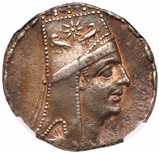 |
Artaxiad Kingdom. Tigranes II 'the Great'. Silver Tetradrachm (15.53 g), 95-56 BC. Tigranocerta, 80-68 BC. Diademed and draped bust of Tigranes II right, wearing tiara decorated with star between two eagles. Reverse: BAΣIΛEΩΣ TIΓPANOY, Tyche seated right on rock, holding laurel branch; below, river-god Orontes swimming right; in right field by leg small Θ; on rock below, HΔ monogram; all within wreath. SCADA grp. 1, obv. die A13 (Antioch); Kovacs 74/1; M&D 2. NGC grade Ch XF; Strike: 5/5, Surface: 3/5. Value $3,500 - UP
Before ruling in the mountainous interior of Anatolia, Tigranes II spent many years as a hostage in the court of Mithradates II of Parthia. When he was 40, Tigranes I died and Tigranes II was able to 'purchase' his freedom by ceding to Parthia a large part of Media Atropatene. Once on the throne he quickly subdued the local barons of Armenia, who hitherto had paid only nominal submission to the king, thus centralizing his rule with a tight grip. He then went on to invade his neighbors, expanding his kingdom in all directions at their expense. During the First Mithradatic War between Mithradates VI of Pontos and Rome, Tigranes was careful to maintain the appearance of neutrality all the while secretly supporting Mithradates. Subsequently, however, he allied with Pontos overtly, marrying Mithradates' daughter, Cleopatra, and sheltering Mithradates when he had been defeated by Rome. This, of course, brought Armenia into direct conflict with Rome, and in two engagements with Lucullus, the Roman consul in charge of pursuing the war against Mithradates, Tigranes was soundly defeated. Lucullus, however, was not successful in capturing either Mithradates or Tigranes, and so after years of conducting an inconclusive war he was recalled to Rome and replaced by Pompey the Great. Pompey was much more effective. He quickly brought Tigranes to heal, forcing him to give up the territories he had conquered during his long reign in return for allowing him to remain on his throne.
View details and enlarged photos
|
|
Lot 17 |
 |
Seleukid Kingdom. Antiochos I Soter. Silver Tetradrachm (16.66 g), 281-261 BC. Aï Khanoum, ca. 280-271 BC. Diademed head of Antiochos I right. Reverse: BAΣIΛEΩΣ ANTIOΧOY, horned and bridled head of horse right; in right field, Δ in circle monogram. SC 430.2c; HGC 9, 132. Rare. NGC grade Ch F; Strike: 4/5, Surface: 2/5. Value $2,000 - UP
View details and enlarged photos
|
|
Lot 18 |
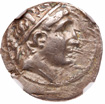 |
Seleukid Kingdom. Antiochos I Soter. Silver Drachm (4.05 g), 281-261 BC. Aï Khanoum, ca. 280-271 BC. Diademed head of Antiochos I right. Reverse: BAΣIΛEΩΣ ANTIOΧOY, horned and bridled head of horse right; in right field, Λ in circle monogram; in exergue, A. Cf. SC 432.3a (monogram); SMAK A1DH-16 (A7/P9 -�this coin); HGC 9, 136. NGC grade Ch XF; Strike: 4/5, Surface: 3/5. Marks. Value $2,000 - UP
View details and enlarged photos
|
|
Lot 19 |
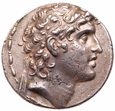 |
Seleukid Kingdom. Alexander I Balas. Silver Tetradrachm (16.77 g), 152/1-145 BC. Uncertain Mint 88, in northern Syria. Diademed head of Alexander I right. Reverse: BAΣIΛEΩΣ AΛEΞANΔPOY [Θ]EOΠATOPOΣ [KA]I EYEPΓETOY, Zeus seated left, holding Nike and scepter. SC 1812 (this coin cited and illus.); CSE 559 (this coin); HGC 875d. Extremely Rare. Lightly toned and minor porosity on obverse. Choice Very Fine. Value $1,500 - UP
Ex Arthur Houghton Collection (CNG 72, 14 June 2006), 950, purchased from MMAG, September 1966.
View details and enlarged photos
|
|
|
|